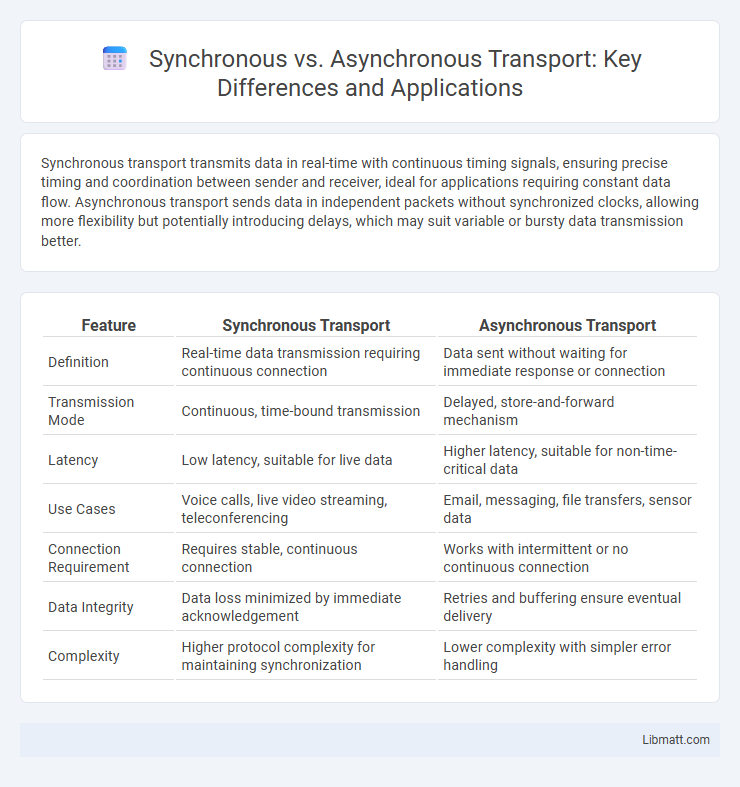Synchronous transport transmits data in real-time with continuous timing signals, ensuring precise timing and coordination between sender and receiver, ideal for applications requiring constant data flow. Asynchronous transport sends data in independent packets without synchronized clocks, allowing more flexibility but potentially introducing delays, which may suit variable or bursty data transmission better.
Table of Comparison
| Feature | Synchronous Transport | Asynchronous Transport |
|---|---|---|
| Definition | Real-time data transmission requiring continuous connection | Data sent without waiting for immediate response or connection |
| Transmission Mode | Continuous, time-bound transmission | Delayed, store-and-forward mechanism |
| Latency | Low latency, suitable for live data | Higher latency, suitable for non-time-critical data |
| Use Cases | Voice calls, live video streaming, teleconferencing | Email, messaging, file transfers, sensor data |
| Connection Requirement | Requires stable, continuous connection | Works with intermittent or no continuous connection |
| Data Integrity | Data loss minimized by immediate acknowledgement | Retries and buffering ensure eventual delivery |
| Complexity | Higher protocol complexity for maintaining synchronization | Lower complexity with simpler error handling |
Introduction to Synchronous and Asynchronous Transport
Synchronous transport transmits data in a continuous stream, relying on a shared clock signal to synchronize the sender and receiver for precise timing. Asynchronous transport, in contrast, sends data in discrete packets with start and stop bits, allowing your devices to communicate without needing synchronized clocks. Choosing between these methods affects how efficiently and reliably data travels across networks or between systems.
Core Definitions: Synchronous vs. Asynchronous Transport
Synchronous transport refers to data transmission where signals are sent and received in a coordinated timing sequence, often using a shared clock, ensuring that sender and receiver remain synchronized throughout the communication. Asynchronous transport transmits data without a shared clock, relying on start and stop bits to frame each byte, allowing for independent timing between sender and receiver. These core differences impact latency, error handling, and the complexity of communication protocols in networking and data transfer systems.
Key Differences in Data Transmission Methods
Synchronous transport transmits data in a continuous stream synchronized by a shared clock signal, enabling real-time communication with minimal delay and precise timing. Asynchronous transport sends data in discrete packets or frames marked by start and stop bits, allowing irregular intervals between transmissions and reducing the need for constant synchronization. The key difference lies in synchronous transmission's reliance on clock synchronization for steady data flow, whereas asynchronous transmission uses event-driven timing, resulting in flexible but potentially less efficient data handling.
Synchronous Transport: Mechanisms and Use Cases
Synchronous transport relies on a continuous, timed data stream where sender and receiver clocks are synchronized to ensure accurate timing and minimal latency. This mechanism is commonly used in telecommunications networks and real-time applications like video conferencing or voice over IP, where consistent data flow is crucial. Understanding synchronous transport helps you optimize your network for time-sensitive communications that demand precise coordination.
Asynchronous Transport: Mechanisms and Applications
Asynchronous transport uses start and stop bits to delimit each data byte, allowing devices to transmit data at irregular intervals without a shared clock signal, which simplifies communication and hardware requirements. Mechanisms such as UART (Universal Asynchronous Receiver/Transmitter) enable asynchronous data transfer, widely applied in serial communication protocols like RS-232 and USB. Your systems benefit from asynchronous transport in applications requiring flexibility and cost-effective implementation, including remote terminal connections, low-speed sensors, and terminal emulators.
Advantages and Limitations of Synchronous Transport
Synchronous transport provides efficient data transmission with minimal latency by sending data in continuous blocks synchronized by a clock signal, making it ideal for real-time applications such as video conferencing and voice over IP (VoIP). The primary advantage lies in its predictable timing, which simplifies error detection and improves bandwidth utilization. However, synchronous transport requires precise clock synchronization between sender and receiver, leading to potential complexity and higher implementation costs, and it may struggle with variable data rates or bursty traffic.
Benefits and Drawbacks of Asynchronous Transport
Asynchronous transport offers the benefit of reduced overhead by transmitting data in irregular intervals without the need for a synchronized clock, improving efficiency for bursty or low-volume traffic. It reduces latency in communication networks as devices can send data as soon as it's ready, enhancing responsiveness in applications like email or web browsing. However, the lack of synchronization can lead to data collisions or errors, requiring robust error-checking and retransmission protocols that may increase complexity and processing overhead.
Performance Comparison: Speed, Latency, and Reliability
Synchronous transport offers lower latency and higher reliability by maintaining continuous data transmission with precise timing, ideal for real-time applications requiring consistent speed. Asynchronous transport provides greater flexibility and efficiency under variable traffic conditions but typically experiences higher latency due to data packetization and variable timing. Understanding your network's performance needs will help you choose the appropriate transport method to optimize speed, latency, and reliability.
Real-World Examples and Industry Applications
Synchronous transport protocols, such as SONET/SDH, are widely used in telecommunications networks for real-time voice and video transmission due to their precise timing and minimal latency. Asynchronous transport, like Ethernet and ATM, supports data packet switching in internet services and cloud computing, offering flexibility for bursty, non-time-critical traffic. Your choice between these depends on the need for timing accuracy versus scalability and cost-efficiency in applications like financial trading (synchronous) or web hosting services (asynchronous).
Choosing the Right Transport Method: Decision Factors
Choosing the right transport method depends on factors such as application latency tolerance, bandwidth availability, and required data consistency. Synchronous transport ensures real-time communication with guaranteed order and delivery but may suffer from higher latency and reduced scalability. Asynchronous transport offers greater flexibility and throughput by allowing loosely coupled systems to process messages independently, making it ideal for distributed environments with variable network conditions.
synchronous vs asynchronous transport Infographic

 libmatt.com
libmatt.com